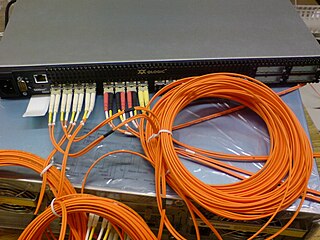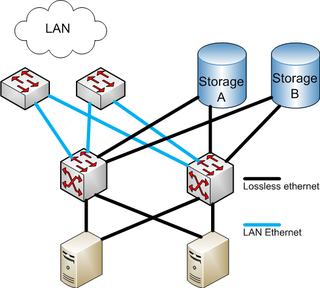
Small Computer System Interface is a set of standards for physically connecting and transferring data between computers and peripheral devices. The SCSI standards define commands, protocols, electrical, optical and logical interfaces. The SCSI standard defines command sets for specific peripheral device types; the presence of "unknown" as one of these types means that in theory it can be used as an interface to almost any device, but the standard is highly pragmatic and addressed toward commercial requirements. The initial Parallel SCSI was most commonly used for hard disk drives and tape drives, but it can connect a wide range of other devices, including scanners and CD drives, although not all controllers can handle all devices.
Internet Small Computer Systems Interface or iSCSI is an Internet Protocol-based storage networking standard for linking data storage facilities. iSCSI provides block-level access to storage devices by carrying SCSI commands over a TCP/IP network. iSCSI facilitates data transfers over intranets and to manage storage over long distances. It can be used to transmit data over local area networks (LANs), wide area networks (WANs), or the Internet and can enable location-independent data storage and retrieval.
Fibre Channel (FC) is a high-speed data transfer protocol providing in-order, lossless delivery of raw block data. Fibre Channel is primarily used to connect computer data storage to servers in storage area networks (SAN) in commercial data centers.

In computer hardware, a host controller, host adapter, or host bus adapter (HBA), connects a computer system bus, which acts as the host system, to other network and storage devices. The terms are primarily used to refer to devices for connecting SCSI, Fibre Channel and SATA devices. Devices for connecting to IDE, Ethernet, FireWire, USB and other systems may also be called host adapters.
A disk array controller is a device that manages the physical disk drives and presents them to the computer as logical units. It almost always implements hardware RAID, thus it is sometimes referred to as RAID controller. It also often provides additional disk cache.

Clariion is a discontinued SAN disk array manufactured and sold by EMC Corporation, it occupied the entry-level and mid-range of EMC's SAN disk array products. In 2011, EMC introduced the EMC VNX Series, designed to replace both the Clariion and Celerra products.
A World Wide Name (WWN) or World Wide Identifier (WWID) is a unique identifier used in storage technologies including Fibre Channel, Parallel ATA, Serial ATA, SCSI and Serial Attached SCSI (SAS).
NetApp, Inc. is an American hybrid cloud data services and data management company headquartered in San Jose, California. It has ranked in the Fortune 500 from 2012 to 2021. Founded in 1992 with an IPO in 1995, NetApp offers cloud data services for management of applications and data both online and physically.

In the computer storage field, a Fibre Channel switch is a network switch compatible with the Fibre Channel (FC) protocol. It allows the creation of a Fibre Channel fabric, that is the core component of a storage area network (SAN). The fabric is a network of Fibre Channel devices which allows many-to-many communication, device name lookup, security, and redundancy. FC switches implement zoning, a mechanism that disables unwanted traffic between certain fabric nodes.
In computing, the proposed Internet Storage Name Service (iSNS) protocol allows automated discovery, management and configuration of iSCSI and Fibre Channel devices (using iFCP gateways) on a TCP/IP network.

The arbitrated loop, also known as FC-AL, is a Fibre Channel topology in which devices are connected in a one-way loop fashion in a ring topology. Historically it was a lower-cost alternative to a fabric topology. It allowed connection of many servers and computer storage devices without using then very costly Fibre Channel switches. The cost of the switches dropped considerably, so by 2007, FC-AL had become rare in server-to-storage communication. It is however still common within storage systems.
A NetApp FAS is a computer storage product by NetApp running the ONTAP operating system; the terms ONTAP, AFF, ASA, FAS are often used as synonyms. "Filer" is also used as a synonym although this is not an official name. There are three types of FAS systems: Hybrid, All-Flash, and All SAN Array:
- NetApp proprietary custom-build hardware appliances with HDD or SSD drives called hybrid Fabric-Attached Storage
- NetApp proprietary custom-build hardware appliances with only SSD drives and optimized ONTAP for low latency called ALL-Flash FAS
- All SAN Array build on top of AFF platform, and provide only SAN-based data protocol connectivity.
Host-based zoning can include WWN or LUN masking, and is typically known as “persistent binding.”

Fibre Channel over Ethernet (FCoE) is a computer network technology that encapsulates Fibre Channel frames over Ethernet networks. This allows Fibre Channel to use 10 Gigabit Ethernet networks while preserving the Fibre Channel protocol. The specification was part of the International Committee for Information Technology Standards T11 FC-BB-5 standard published in 2009.

A storage area network (SAN) or storage network is a computer network which provides access to consolidated, block-level data storage. SANs are primarily used to access data storage devices, such as disk arrays and tape libraries from servers so that the devices appear to the operating system as direct-attached storage. A SAN typically is a dedicated network of storage devices not accessible through the local area network (LAN).
Cluster Shared Volumes (CSV) is a feature of Failover Clustering first introduced in Windows Server 2008 R2 for use with the Hyper-V role. A Cluster Shared Volume is a shared disk containing an NTFS or ReFS (ReFS: Windows Server 2012 R2 or newer) volume that is made accessible for read and write operations by all nodes within a Windows Server Failover Cluster.
RecoverPoint is a continuous data protection product offered by Dell EMC which supports asynchronous and synchronous data replication of block-based storage. RecoverPoint was originally created by a company called Kashya, which was bought by EMC in 2006.

In computing, Linux-IO (LIO) Target is an open-source implementation of the SCSI target that has become the standard one included in the Linux kernel. Internally, LIO does not initiate sessions, but instead provides one or more Logical Unit Numbers (LUNs), waits for SCSI commands from a SCSI initiator, and performs required input/output data transfers. LIO supports common storage fabrics, including FCoE, Fibre Channel, IEEE 1394, iSCSI, iSCSI Extensions for RDMA (iSER), SCSI RDMA Protocol (SRP) and USB. It is included in most Linux distributions; native support for LIO in QEMU/KVM, libvirt, and OpenStack makes LIO also a storage option for cloud deployments.
ONTAP or Data ONTAP or Clustered Data ONTAP (cDOT) or Data ONTAP 7-Mode is NetApp's proprietary operating system used in storage disk arrays such as NetApp FAS and AFF, ONTAP Select, and Cloud Volumes ONTAP. With the release of version 9.0, NetApp decided to simplify the Data ONTAP name and removed the word "Data" from it, and remove the 7-Mode image, therefore, ONTAP 9 is the successor of Clustered Data ONTAP 8.







